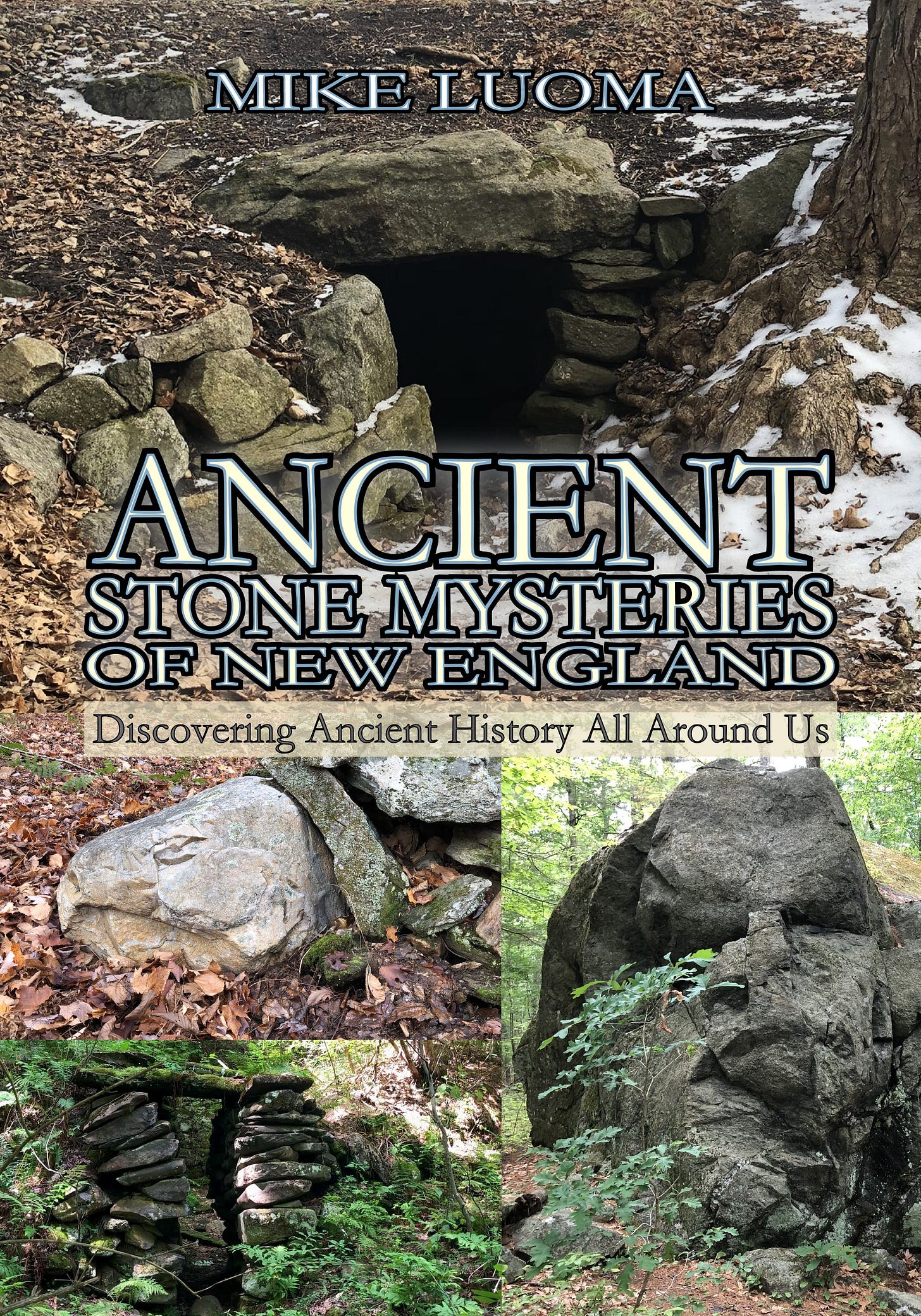
Introduction
Sometimes, exploring means discovering there is much we do not know.
I’m author and researcher Mike Luoma.
When my Ancient Stone Mysteries of New England Facebook Group began a couple of years ago, a mere handful of us shared and commented on posts, pictures and video of the possibly ancient stonework we found. These days, interest is booming – we’ve gone over 11,000 Members as I write. You’re welcome to join us at:
https://www.facebook.com/groups/ancientstonemysteries.
There’s an undeniable and growing interest in the possibly ancient stonework we’re re-discovering all around us in New England and beyond.
Maybe that’s why you’re reading this book right now.
Maybe – like me – you’re discovering you don’t know as much as you once thought you did about the stonework of New England. Maybe you’ve come across mysterious stonework or know someone who has. And you want to know more.
Maybe you’ve seen fringe-history shows and videos suggesting ancient European explorers, Celts, Phoenicians, Templars, Vikings, and such, were here and building stone chambers and leaving strange marks for centuries before Columbus arrived offshore.
Maybe you’ve heard all the stone walls were built during a “sheep craze” in the 19th century, or are All Colonial, or are simply horizontal clearing piles, or farmer’s trash piles, and are wondering what all the fuss is about.
Or maybe you’ve come across the idea that some of the old stonework found in the woods, parks, preserves and forests of New England predates the European settling of North America and is of Indigenous origin. Perhaps you’ve heard the term Ceremonial Stone Landscapes.
You may be discovering – for the first time – that there even is ancient Indigenous Stonework in Northeastern North America.
There is?
Oh yes. There is.
It’s all around us. If you know where – and how – to look.
In a way, that’s what this book is about – how I learned to look at the stonework and learned to see the Possible Indigenous Work within. As a non-Indigenous journalist, that’s the story I can tell – what I’ve observed and discovered through my experiences of these possibly sacred stone sites – while sharing research and knowledge gained in the effort to understand their meanings and histories.
My own personal voyage of discovery brought me from ignorance, on through entertaining wild speculation, into experiencing these as Ceremonial Stone Landscapes, all while learning a deeper history of the places where I’ve lived, one which I’d never truly known.
I’m in my mid-fifties. As kids in the 1970’s, we were taught, “Indians in New England never worked with stone,” and, “Indians never lived in Vermont” – among other cultural denials turned “common knowledge” which turned out to be lies. We learned and re-perpetuated many falsehoods, erasures, and other omissions regarding New England’s Indigenous populations.
Learning the truth, in middle age, has been rather eye-opening.
In studying the Indigenous stonework of New England, I found I’d grown up a mile away from the oldest stone wall ever discovered in Massachusetts… and never knew it. Even rode my bike past it as a kid. This archaeologically documented indigenous stone construction was over 4000 years old!
It turns out, Indigenous folks in New England have been working with stone for a very long time. But no one spreads that news. On top of which, this ancient wall was deliberately destroyed, the site dynamited to make way for a highway access road. Stone structures in Massachusetts are often sacrificed in the name of development and progress.
Close to my current home, in Burlington, Vermont, they’ve excavated ancient Indigenous campsites along the former banks of the Champlain Sea which date back 11,500 years (like the 4000-year-old wall to the south, these were also discovered thanks to highway work). In Burlington’s Intervale (beginning a few hundred feet from my place in the city’s Old North End), they’ve discovered evidence of Abenaki habitation going back thousands of years. Indigenous people not only live and have lived in Vermont, they have continuously for a very, very long time.
Yes, “Indians” lived in Vermont.
They likely resided in many other places in New England, too, places where supposedly “Indians didn’t live, they just passed through/hunted/fished/etc.” The concept’s absurdity becomes evident in its repetition in place after place, town after town. It seems to be an obvious and soothing lie told to themselves by the descendants of those settlers who took lands from the Indigenous, at best playing on willful ignorance of the seasonal cycles of Indigenous habitation. It is as if the Indigenous almost didn’t live… anywhere. This is true Erasure – very real and still occurring.
The opposite appears to be true. Given what’s been discovered across disciplines in the last hundred years, from environmental scientists to anthropologists to archaeologists, we now know this continent wasn’t a Pristine Wilderness but a well-populated, well-tended land of multiple crops, planted vegetation and curated forests – parklike, according to some of the earliest European witnesses.
The Indigenous pretty much lived Everywhere, for thousands and thousands of years, until coming into Contact with European settlers. We now live where they lived, walk paths they walked, and travel roads they traveled.
(continued…)
******
From the Introduction to my new book Ancient Stone Mysteries of New England. Learn more at https://AncientStoneMysteries.com.




